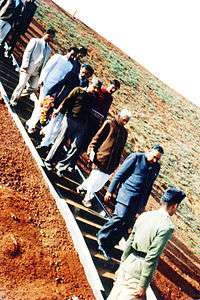Bansagar Dam
Bansagar or Ban Sagar Dam is a multipurpose river Valley Project on Sone River situated in the Ganges Basin in Madhya Pradesh, India with both irrigation and 435 MW of hydroelectric power generation .[1]
| Bansagar Dam | |
|---|---|
View of Bansagar Dam from down stream | |
| Location | shahdol, Madhya Pradesh |
| Coordinates | 24°11′30″N 81°17′15″E |
| Construction began | 14 May 1978 |
| Opening date | 25 September 2006 |
| Operator(s) | Water Resources Department, Madhya Pradesh |
| Dam and spillways | |
| Impounds | Sone River |
| Height | 67 m (220 ft) |
| Length | 1,020 m (3,350 ft) |
| Reservoir | |
| Creates | Bansagar Reservoir |
The Bansagar Dam across the Sone River was constructed near the Deolond village in the Shahdol district. It is surrounded by Satna, Katni, and Rewa districts. The project was called "Bansagar" after Bana Bhatt, the renowned Sanskrit scholar of the 7th century, who is believed to have hailed from this region in India. Bansagar Dam is located at Latitude 24-11-30 N and Longitude 81-17-15 E.
The project was initially called the "Dimba Project" in 1956 by the Central Water Commission, New Delhi to be constructed on the Sone River at the confluence of the Sone and Banas Rivers near Shikarganj town 30 km down river from the present site. Later it was shifted to the present site at Deolond. There was an agreement in 1973 between the State Governments of Madhya Pradesh, Uttar Pradesh and Bihar for the construction of the dam, in which the states shared the expenditure in the ratio of 2:1:1. The 4 million-acre-feet of water is also shared by the states in the same ratio. The construction work was started in 1978 at original approved cost of Rs. 91.31 crores. The final estimated cost in 1998 was Rs. 1054.96 crores.[2]
Bansagar Dam and reservoir data
- Catchment area : 18648 km²
- Dam height : 67 meter
- Dam length : 1020 meter,
- Dam type : Masonry/Earthen
- Spillway capacity : 47,742 m³/s
- Live storage : 5.41 km³
- Submergence area : 587.54 km²
- Population affected : 142,000
- Villages submerged : 336
- Year of start : 1978
- Year of completion : 2006
- beneficiary : farmers
Project benefits
Irrigation
The water sharing from Bansagar Dam is as under:
- Madhya Pradesh : 2,000,000 acre feet (2.5 km3)
- Uttar Pradesh : 1,000,000 acre feet (1.2 km3)
- Bihar : 1,000,000 acre feet (1.2 km3)
Bansagar will irrigate an area of 2,490 km² in Madhya Pradesh, 1,500 km²; in Uttar Pradesh and 940 km² in Bihar.
Power generation
It also provides power generation of 425 MW in Madhya Pradesh.
Bansagar Canal Project
The Bansagar Canal Project started in 1978 was handed over to the nation by PM Narendra Modi on 15 July 2018. Following Canal System, which will utilize water from the Bansagar Reservoir, are in progress as under:
| Canal System | Length (km) | Annual irrigation (ha) |
|---|---|---|
| Common Water Carrier | 36.57 | No direct irrigation |
| Right Bank Canal | 30.80 | 5059 |
| Bhitari Canal | 11.20 | 2730 |
| Sihawal Canal | 75.30 | 27143 |
| Keoti canal | 90.00 | 45528 |
| Purwa Canal | 128.90 | 74084 |
| Gurh Mauganj Canal | 65.00 | 24654 |
| Teonthar Lift Canal | 40.96 | 14161 |
Submergence of Bansagar
The land submerged by Bansagar dam at Full Reservoir Level (F.R.L 341.64 m.) is 587.54 km², out of which 40.73 km² is forest land, 175.90 km² revenue land 1.31 km² public land and 369.59 km² private land.
336 villages were submerged by the Bansagar Reservoir: 79 villages are fully submerged and 257 are partially submerged.
Fully submerged villages
The 79 fully submerged villages in Bansagar have been displaced and lost their geographical existence from the map. Some of the historically important villages submerged fully were Ramnagar, Deorajnagar, Baraundha, Markandeya-ghat, Darbar etc. The districts of these submerged and lost villages are as under:
Satna district (50 villages)
Amjhori Dakshin, Baikona No.-2, Bela (Near Remar), Bamhauri (Bimhauri), Barauli, Baikona No.-1, Bara, Barsajaha, Bela Tiwari, Banneh, Chhirahai, Deoraj nagar, Dhol baja, Dala, Daga Kothar, Dighiya Khurd, Garehara, Gurha, Hinauta Khurd (Unumukt), Hinauta Khothar, Itma (Near Deoraj Nagar), Itma (Near Ram Nagar), Jarmani, Jirauha, Kusmaha, Khajura, Khajuri, Kauhara, Kareha bela, Kothar, Karahiya, Kalla Khurd, Kalla Kala, Ladwad No.-1, Ladwad No.-2, Mala Dabar, Mirgauti, Mauhari, Patha, Patehari, Poriya, Parariya, Pipari Dakshin, Rimar, Semariha, Semra, Singhpur, Semariya (Sanaga), Tilokawa kotar Naudhiya, Tikari, khajura
Shahdol district (22 villages)
Bodra, Barundha, Dhanedi Purva, Dhaneda, Dhanedi Pashchim, Dhanedi Vikram, Ghusira, Jamun Darhi, Jhirkona, Kusiara, Karahiya, Karri, Karaundiya Pashchim, Karaundiya Purva, Karaundiya Kothar, Kanbau, Kachhara Tola, Marha, Magaraha, Palwahi, Pahariya, Sonvarsha, Bartona, Riha, Sapta, Jamuni, Odari, Pathrehi, Sarsi, Khadeh
Katni district (6 villages)
Amakola, Doli, Itahara, Kudri, Naubasta, Podi
Umaria district (3 villages)
Darbar, Sahijana, Hinauti, Bholgarh, Chap, Padkhudi

Dedicated to nation
The foundation stone of the Bansagar project was laid by the late Prime Minister Morarji Desai on 14 May 1978.[3] The project was inspected and allocated sufficient funds in every five-year plan by the endless attempts of Pandit Ram Kishore Shukla former finance minister of Madhya Pradesh. The Bansagar Dam was dedicated to the nation on 25 September 2006 by Atal Bihari Vajpayee, former Prime Minister of India.
Footnotes
- Water Resources of Madhya Pradesh: Major Projects, Water Resources Department, Government of Madhya Pradesh, January 2006
- Water Resources of Madhya Pradesh: Major Projects, Water Resources Department, Government of Madhya Pradesh, January 2006
- Hindustan Times, New Delhi: 26 September 2006
References
- Water Resources of Madhya Pradesh: Major Projects, Water Resources Department, Government of Madhya Pradesh, January 2006
- Hindustan Times, New Delhi: 26 September 2006